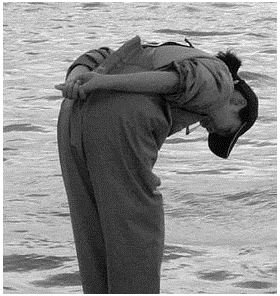Conscious Body Language and Gestures - Bowing, Cheek Kissing, & Nodding
Bowing
One of the most important head movements used in body language is bowing. According to culture and custom, the bow signifies different things and is executed in different ways.
Bowing has the most ample meaning in East Asia, particularly in Japan. The meaning varies depending on the way the bow is executed and the depth and length of the inclination of the head. Always executed from the waist with the hands by the side, the bow conveys different expressions such as, greeting, apology, gratitude, humility, respect or remorse. Note that in Asia it is considered impolite to make eye contact whilst bowing. It might convey distrust (I do not dare take my eyes off you!) Bowing generally is a body language all by itself in East Asia.
In Europe, the bow is a form of greeting and respect and is often accompanied by a handshake. It is not impolite to look the other person in the eye while bowing in Europe; it is instead a courtesy to do so and considered rude or even shifty not to. Bowing is an exclusively male gesture. Women do not bow whilst shaking hands. The depth of the bow depends on the rank and sometimes the gender of the greeted person. The European style bow is not executed from the waist but by an inclination of the head. Older and very formal men, particularly German and Austrian, often accompany the bow with a hand kiss when greeting an older woman. Teenagers do not get their hands kissed. The much ridiculed German “click of the heels" is not done anymore, at least not in social and civil settings. Military rituals are of course another matter.
Cheek Kissing
Kissing the cheek is a very common form of greeting in Southern Europe and Latin America. Sometimes both cheeks are kissed; sometimes only one cheek is touched lightly by the lips. The kisses are accompanied by a handshake or by putting one’s hands on the other person’s shoulders. Women often air-kiss to avoid leaving a trace of lipstick on the greeted person’s cheek. Although cheek kissing is a sign of affection, it can also be conceived as an invasion of private space and one should therefore be guided by what the other person does.
In Southeast Asia and any other country influenced by Muslim or Hindu culture, cheek kissing – especially a woman – is offensive and must be avoided.
Nodding

Another body language signal involving the head is nodding. The head is bobbed vertically once or several times and the gesture generally conveys approval and consent. However, in Bulgaria and Thailand, nodding means the opposite: a very definite “no”. Vigorous nodding usually means strong approval, whereas nodding slowly several times can convey, “Maybe, but I’ll have to think about it.”
References
-
Image Credits
Cheek Kissing Image: Jean Honore Fragonard/Public Domain/commons.wikimedia.org/wiki/File:Jean_Honore_Fragonard_The_Stolen_Kiss.jpg
Bowing Image: Paul Synnott/commons.wikimedia.org/wiki/File:Female_bowing_to_whale.jpg/creativecommons.org/licenses/by/2.0/deed.en
Nod Image: Infrogmation/Public Domain/commons.wikimedia.org/wiki/File:WaitingForYouPostcard1909.JPG
-
“Bodytalk: The Meaning of Human Gestures”; Desmond Morris; 1994
-
“Gesture and Thought”; David McNeill; University Of Chicago Press; November 8, 2005
This post is part of the series: Conscious and Involuntary Body Language
50-60% of communication is conducted by body language, whether conscious through gestures or involuntarily through reactions. Learn about differences, similarities and interpretations according to countries and cultures.
